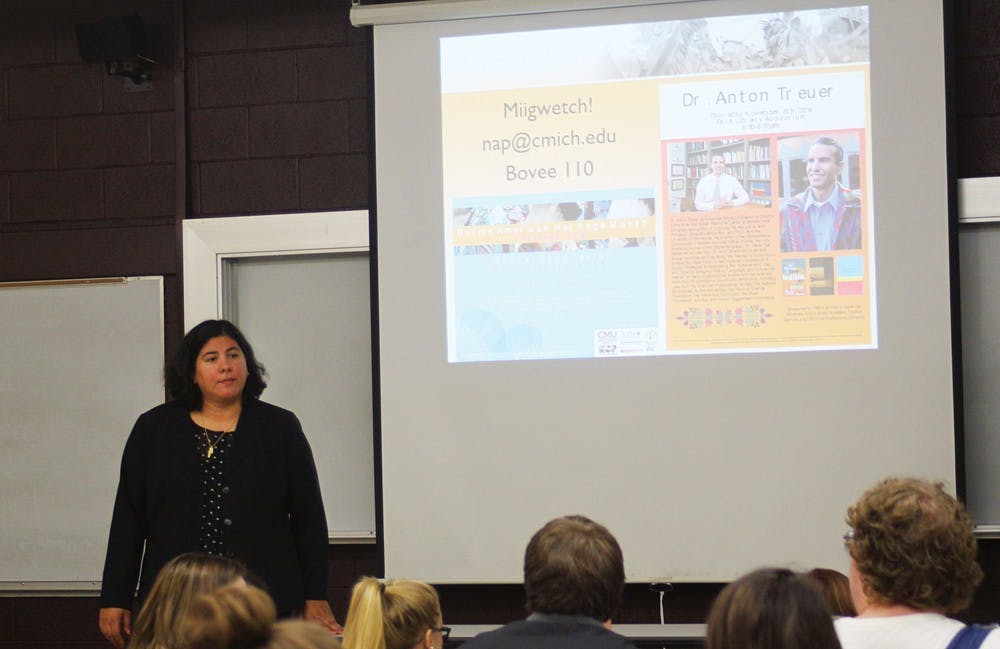Students gain new perspectives through Native American Programs

Native American Programs at Central Michigan University are debunking stereotypes about indigenous people's culture, one at a time.
Colleen Green, director of Native American Programs, and Hannah Bartol, a freshman from the Hannahville Indian Community near Escanaba, spoke to a group of students in JRN 380: Racial and Cultural Diversity: Mass Media’s Role, Monday about Native culture.
“It’s about educating people about other cultures,” Green said. “Be allies and advocates for other cultures, not necessarily (just) Native Americans.”
Green, Bartol and other staff members with Native American Programs bring their presentation to classes that request it. They discuss common stereotypes against Native Americans, their history, misconceptions perpetuated by the media and resources on campus.
Bartol enjoys presenting her insight to students because it gives her the opportunity to quell common misconceptions about Native Americans.
“It’s about dispelling the stereotypes and the things their parents might tell them,” she said. “I can educate them on why things are a certain way.”
Several students in the class were surprised to learn some of the myths about traditional Native American clothing, as well as other topics.
Waterford junior Erica Heintz was surprised to learn the headbands Native Americans are sometimes depicted wearing in popular culture, are not part of their tradition and were created for their aesthetic value by whites.
“I thought those random facts were interesting, and I could kind of see where they were coming from already,” Heintz said.
Cameron Johnson, a freshman from Lake Odessa, said she is interested in Native American education and getting the facts about reduced costs for Native American students.
“I didn’t know about the free education (for Michigan universities). I didn’t know that it was just the tuition, and they still have to pay for other things,” she said.
They discussed the Saginaw Chippewa Indian Tribe’s relationship with the university, which included the use of the “Chippewa” nickname, an articulation agreement providing easy transfer for Native college students, a university-sponsored archaeological dig at the local boarding school and a resolution signed in 2002 outlining the pair’s mutual cooperation.
Green compared the way CMU handles potential issues with a Native American nickname for its sports teams to other schools like Florida State University. Discussion on the Florida State Seminoles and Chippewa nicknames was particularly interesting for Brad Tunney, Clinton Township sophomore.
“I’ve discussed a lot about the Redskins,” he said. “It was good to hear from somebody that you actually kind of know and get their opinion on it so you can have both sides of the story on it.”
Mike Marn, fixed-term journalism faculty member, said he gave his students a survey asking them about the importance of the issue of Native American mascots and would be interested to see how the results might have changed after the presentation.
“One of the problems with stereotyping is that you’re never in a position to see the perspective of the group that’s being stereotyped,” he said. "We don’t know what that feels like, we can only imagine, so it helps us get to that other side a little bit better when we can actually hear that experience relayed through the people who lived it.”
It’s important for his students to realize that Native Americans do not live as they have been depicted by the media, Marn said, and the social issues surrounding them are relevant today.
“I might say something that would offend someone who is a Native,” Heintz said. “You don’t mean it offensively, but it definitely makes you think differently, and it gives you different perspective that you never would have thought before.”
In addition to visiting classrooms across campus, Native American Programs also hosts cultural workshops in residence halls upon request, where residents often make a traditional Native craft while learning the history and meaning behind it.



